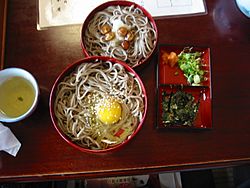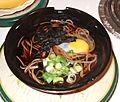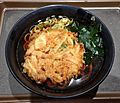Soba facts for kids
|
Dried soba noodles
|
|
| Type | Noodles |
|---|---|
| Place of origin | Japan |
| Serving temperature | Hot, cold |
| Main ingredients | Buckwheat |
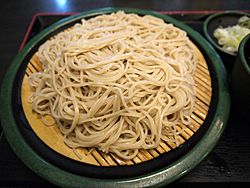
Soba (蕎麦) is a popular type of thin Japanese noodle. It is made from buckwheat flour. You can enjoy soba noodles either cold with a special dipping sauce, or hot in a tasty broth like a noodle soup. In Japan, sometimes any thin noodle is called soba, to tell it apart from udon, which are thick wheat noodles.
Making soba noodles from pure buckwheat can be tricky because they might break when boiled. So, buckwheat flour is usually mixed with other ingredients, often wheat flour, to help them stick together. For noodles to be called soba in Japan, they must have at least 30% buckwheat. However, noodles with more buckwheat are usually seen as better quality.
To make raw soba, a dough is first created from buckwheat flour and a binder. This dough is then rolled out flat. After that, thin strands of noodles are carefully cut using a special knife. The quality of the noodles depends a lot on how skilled the person making them is, especially for soba with a lot of buckwheat. Before serving, the raw noodles are boiled.
In Japan, soba noodles are eaten in many different places. They are a popular and cheap fast food at train stations. You can also find them in fancy, expensive restaurants. Many people also make soba at home. Stores sell dried soba noodles and men-tsuyu, which is an instant noodle broth, to make cooking at home easy.
Some places, especially casual ones, might serve both soba and udon noodles. This is because both types of noodles are often served in similar ways. However, soba has traditionally been the favorite noodle for people living in Tokyo. This tradition started a long time ago during the Edo period. People in Edo (old Tokyo) were richer than those in the countryside. They ate a lot of white rice, which is low in a vitamin called thiamine. Eating soba, which has more thiamine, helped them stay healthy. Back then, every neighborhood had soba shops, many also serving sake. These shops were like modern cafes where people would casually visit.
Contents
How to Enjoy Soba Noodles
Soba is almost always eaten with chopsticks. In Japan, it is polite to slurp your noodles loudly. This is especially true for hot noodles, as slurping helps cool them down quickly as they enter your mouth.
Popular Soba Dishes
Like many Japanese noodles, soba is often served cold and drained in the summer. In winter, it is usually served hot in a soy-based dashi broth. You can add extra toppings to both hot and cold soba. Toppings are chosen to match the seasons and to go well with other ingredients. Most toppings are added without much cooking, though some are deep-fried. Many of these dishes can also be made with udon noodles. Soba noodles are usually about 1.5 millimeters wide.
Cold Soba Dishes
Chilled soba is often served on a bamboo tray that looks like a sieve, called a zaru. Sometimes, it has bits of dried nori seaweed on top. A dipping sauce called soba tsuyu is served on the side. This tsuyu is a strong mix of dashi, sweet soy sauce, and mirin.
To eat, you pick up a small amount of soba with your chopsticks. Then, you swirl it in the cold tsuyu before eating. People often mix wasabi, scallions, and grated ginger into the tsuyu for extra flavor.
- Mori soba 盛り蕎麦 – Basic chilled soba noodles served on a flat basket or plate.
- Zaru soba 笊蕎麦 – Mori soba with shredded seaweed on top.
- furikake soba – Cold soba served with different toppings sprinkled on top. The broth is poured on by the person eating. It may include:
- Soba maki – Cold soba wrapped in nori and prepared like makizushi.
Hot Soba Dishes
Soba is also often served as a noodle soup in a bowl of hot tsuyu. The hot tsuyu for soup is thinner than the dipping sauce used for cold soba. Popular toppings are sliced scallion and shichimi toragashi (a mix of chili powders).
- Kake soba 掛け蕎麦 – Hot soba in broth, topped with thinly sliced scallion and sometimes a slice of kamaboko (fish cake).
- Kitsune soba (in Kanto) or Tanuki soba (in Kansai) – Topped with abura age (deep-fried tofu).
- Tanuki soba (in Kanto) or Haikara soba (in Kansai) – Topped with tenkasu (small bits of deep-fried tempura batter).
- Tempura soba 天麩羅蕎麦 – Topped with tempura, usually a large shrimp.
- Tsukimi soba ("moon-viewing soba") – Topped with a raw egg, which cooks in the hot soup.
- Tororo soba – Topped with tororo, a smooth paste from yamaimo (a potato-like vegetable).
- Wakame soba – Topped with wakame seaweed.
Soba for Special Times
Soba is traditionally eaten on New Year's Eve in most parts of Japan. This tradition is still very popular today. In the Tokyo area, there was also a custom of giving soba to new neighbors after moving into a new house. However, this practice is not very common anymore.
Different Kinds of Soba Noodles
Some of the most famous Japanese soba noodles come from Nagano. Soba from Nagano is called Shinano Soba or Shinshu soba. Ni-hachi (two-eight) soba is a type that has two parts wheat flour and eight parts buckwheat flour.
- Sarashina soba – These are thin, light-colored soba noodles, made from very refined buckwheat.
- Inaka soba – Also known as "country soba," these are thicker soba noodles made using whole buckwheat.
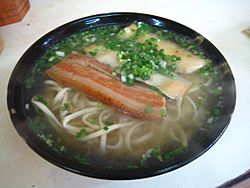
Soba by Location
- Shinshu soba – Named after the old name of Nagano Prefecture. Also known as Shinano soba.
- Etanbetsu soba – Named after a central region in Hokkaidō (near Asahikawa city).
- Izumo soba – Named after Izumo in Shimane.
- Izushi soba – Named after Izushi in Hyogo.
- Miyako soba - Named after the Miyako Island in Okinawa.
Soba by Ingredients
- Tororo soba or Jinenjo soba – These noodles are flavored with wild yam flour.
- Cha soba – These noodles are flavored with green tea powder.
- Mugi soba – These noodles are flavored with mugwort.
- Hegi soba – These noodles are flavored with seaweed.
- Ni-hachi soba – Soba containing 20% wheat flour and 80% buckwheat flour.
- Towari soba or Juwari soba – These are 100% buckwheat soba noodles.
Other Meanings of Soba
The word soba is also the Japanese word for buckwheat. Roasted buckwheat kernels can be used to make a grain tea called sobacha, which can be served hot or cold. Buckwheat hulls, called sobakawa, are sometimes used to fill pillows.
Sometimes, soba is used to mean noodles in general. In Japan, ramen is sometimes called chūka soba or shina soba (both mean Chinese noodles). Parboiled chūka soba is stir-fried to make yakisoba. It's important to know that these noodles do not contain buckwheat.
In Okinawa, soba usually refers to Okinawa soba. This is a completely different dish made from wheat flour noodles, not buckwheat. Okinawa soba is also very popular in the city of Campo Grande (Brazil). This is because of the many Japanese (Okinawan) immigrants there. You can eat it at street markets or in special restaurants called "sobarias."
See also
Images for kids
-
Edo Yatai replica
-
Kawara soba. Cha-Soba dish.
-
Kitsune Soba in Brighton, East Sussex, UK (Abura-age)
-
Tanuki Soba in Cupertino, California, US (Tenkasu)
-
Tsukimi Soba (Raw egg)
-
Nameko soba 㠪゠㠓ã ã °.jpg
Nameko Soba (Pholiota microspora mushrooms)
-
Kamonanban (Duck)
-
Korokke soba
-
Tempura soba (Kakiage)
See also
 In Spanish: Soba (alimento) para niños
In Spanish: Soba (alimento) para niños



